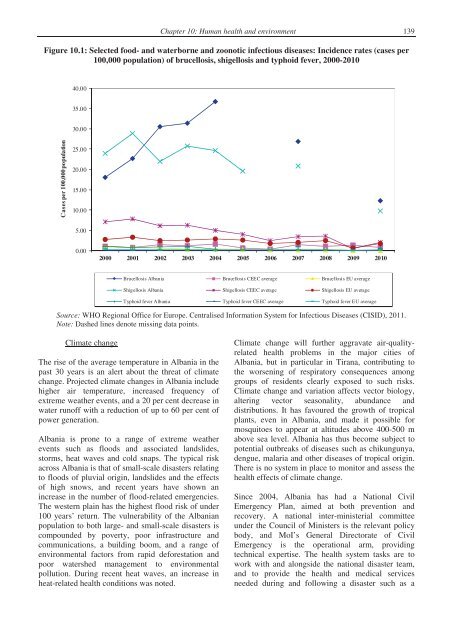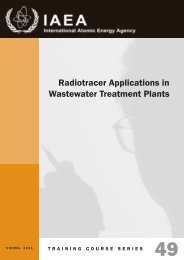Second Environmental Performance Review of Albania
Second Environmental Performance Review of Albania
Second Environmental Performance Review of Albania
You also want an ePaper? Increase the reach of your titles
YUMPU automatically turns print PDFs into web optimized ePapers that Google loves.
Chapter 10: Human health and environment139Figure 10.1: Selected food- and waterborne and zoonotic infectious diseases: Incidence rates (cases per100,000 population) <strong>of</strong> brucellosis, shigellosis and typhoid fever, 2000-201040.0035.0030.00Cases per 100,000 population25.0020.0015.0010.005.000.002000 2001 2002 2003 2004 2005 2006 2007 2008 2009 2010Brucellosis <strong>Albania</strong> Brucellosis CEEC average Brucellosis EU averageShigellosis <strong>Albania</strong> Shigellosis CEEC average Shigellosis EU averageTyphoid fever <strong>Albania</strong> Typhoid fever CEEC average Typhoid fever EU averageSource: WHO Regional Office for Europe. Centralised Information System for Infectious Diseases (CISID), 2011.Note: Dashed lines denote missing data points.Climate changeThe rise <strong>of</strong> the average temperature in <strong>Albania</strong> in thepast 30 years is an alert about the threat <strong>of</strong> climatechange. Projected climate changes in <strong>Albania</strong> includehigher air temperature, increased frequency <strong>of</strong>extreme weather events, and a 20 per cent decrease inwater run<strong>of</strong>f with a reduction <strong>of</strong> up to 60 per cent <strong>of</strong>power generation.<strong>Albania</strong> is prone to a range <strong>of</strong> extreme weatherevents such as floods and associated landslides,storms, heat waves and cold snaps. The typical riskacross <strong>Albania</strong> is that <strong>of</strong> small-scale disasters relatingto floods <strong>of</strong> pluvial origin, landslides and the effects<strong>of</strong> high snows, and recent years have shown anincrease in the number <strong>of</strong> flood-related emergencies.The western plain has the highest flood risk <strong>of</strong> under100 years’ return. The vulnerability <strong>of</strong> the <strong>Albania</strong>npopulation to both large- and small-scale disasters iscompounded by poverty, poor infrastructure andcommunications, a building boom, and a range <strong>of</strong>environmental factors from rapid deforestation andpoor watershed management to environmentalpollution. During recent heat waves, an increase inheat-related health conditions was noted.Climate change will further aggravate air-qualityrelatedhealth problems in the major cities <strong>of</strong><strong>Albania</strong>, but in particular in Tirana, contributing tothe worsening <strong>of</strong> respiratory consequences amonggroups <strong>of</strong> residents clearly exposed to such risks.Climate change and variation affects vector biology,altering vector seasonality, abundance anddistributions. It has favoured the growth <strong>of</strong> tropicalplants, even in <strong>Albania</strong>, and made it possible formosquitoes to appear at altitudes above 400-500 mabove sea level. <strong>Albania</strong> has thus become subject topotential outbreaks <strong>of</strong> diseases such as chikungunya,dengue, malaria and other diseases <strong>of</strong> tropical origin.There is no system in place to monitor and assess thehealth effects <strong>of</strong> climate change.Since 2004, <strong>Albania</strong> has had a National CivilEmergency Plan, aimed at both prevention andrecovery. A national inter-ministerial committeeunder the Council <strong>of</strong> Ministers is the relevant policybody, and MoI’s General Directorate <strong>of</strong> CivilEmergency is the operational arm, providingtechnical expertise. The health system tasks are towork with and alongside the national disaster team,and to provide the health and medical servicesneeded during and following a disaster such as a
















